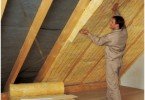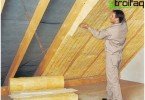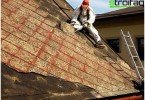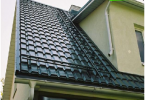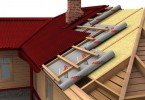Insulation for roof and roof
Roof insulation is a significant barrier in the winter for the cold, and in the summer for the heat. From the correct choice of insulation and the quality of the work performed depends on how well you manage to keep the heat in your home and keep the interior decoration. In the summer, a sufficient thickness of the insulation for the roof can become a good barrier against the scorching heat. A properly insulated roof will provide coolness throughout the house even on the brightest sunny day..
Content
- Fibrous insulation materials
- Glass wool – a budget option
- Spatula fiber for thermal insulation
- Mineral wool boards
- Easy safe cellulose insulation
To answer the question of what insulation to choose for a roof, you need to know its type. Roofs can be pitched and flat, such that are operated, and vice versa.
A good insulation for the roof should have the following properties:
- durability;
- thermal insulation;
- soundproofing;
- moisture resistance;
- vapor permeability;
- biostability;
- environmental friendliness;
- Fire safety.
Subject to these parameters, the roof of the house will protect from moisture, heat, prevent heat loss, allow the room to “breathe” and will be safe for the owners themselves.
Unhappy roofs are most often insulated. If there is an attic and it is not in operation, then only its floor is insulated. If a room or an attic is equipped in the attic, then the slopes of the room are also insulated. Flat roofs without an attic, as well as pitched roofs, under which the room is immediately located, are insulated without fail.
The insulation for the roof must be at least 25 mm thick. The most optimal option is 100 mm. There are fibrous and cellular insulation. They are fixed in the form of plates or applied by spraying.
Fibrous insulation materials
Glass wool – a budget option
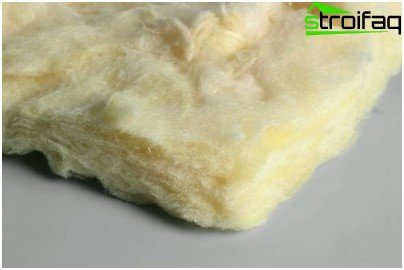
The main advantage of glass wool is its low cost.
Glass wool insulation is the cheapest. They cope with thermal insulation. These are the main advantages. Otherwise, there are more flaws. They are difficult to use both on pitched and straight roofs. Glass wool is highly deformed and absorbs moisture.
Therefore, it must be fixed on the roof and well protected from getting wet. The environmental properties of glass wool also leave much to be desired. Glass wool is not considered environmentally friendly..
Spatula fiber for thermal insulation
Excellent thermal insulation properties are characteristic of spatula fiber, and moisture resistance is better compared to glass wool. And environmental safety is much higher. When installing additional safety measures, as in the case of glass wool, are not necessary. A compacted spatula fiber is used for thermal insulation of both internal and external structures. Suitable material for a straight and pitched roof. The large weight of the material contributes to its additional fixing on the slopes.
Mineral wool boards
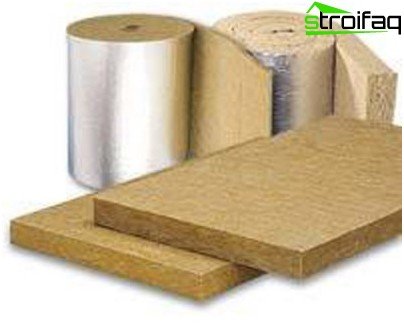
Mineral wool slabs and rolls retain heat very well, eliminate noise penetration, last a long time, are easy to install
This insulation for the roof has other names: stone wool, mineral wool slabs or mineral wool. The material is based on basalt. It is heated and pressed, dense plates or mats are formed from it. Such plates have environmental friendliness, incombustibility, durability, environmental neutrality, good thermal insulation properties. At the same time, the plates retain heat, protect from noise, but allow the house to breathe, since they have good vapor permeability. Of the shortcomings in the mineral wool there is a low moisture resistance. To avoid problems with shrinkage of plates, loss of thermal insulation properties, mineral wool must be additionally waterproofed to prevent moisture from entering. This material is also easy to install, as it is resistant to mechanical stress and deformation..
Among building materials of this type, the most recommended products are companies Ursa (Germany), Izomat (Slovakia), Rockwool (Denmark), Paroc (Finland).
Easy safe cellulose insulation
This is a very loose thermal insulation material based on recycled cellulose. It consists of 81% cellulose, and in addition to it, it contains 7% antiseptics and 12% non-volatile flame retardants. Thanks to antiseptics, biostability of the material is ensured. When applied to a tree, it additionally protects it from decay and extends the life of structures to 100 years..
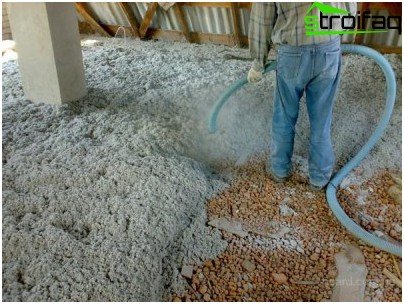
The application of cellulose insulation not ceiling overlap practically does not affect the weight of the building structure
Cellulose insulation is very light and completely safe. Its components are completely non-toxic and even in case of fire no toxic substances are released. Fire retardants are added to cellulose, which effectively slow down the spread of fire..
Also, cellulose insulation has excellent sound and heat insulation qualities. It allows the roof to breathe. But at the same time it must be additionally insulated from moisture. The material is laid on the roof between the rafters with the help of a blowing installation, which allows for seamless insulation.
Such insulation is produced by the brands Isofloc, Climacell, Steico (Germany), EkoVilla (Finland), Isofiber (Norway), Ecowool (Canada and the USA), Ecowool (Russia and Kazakhstan), Unizol (Ukraine).
Cellular materials for roof insulation
Practical extruded polystyrene foam
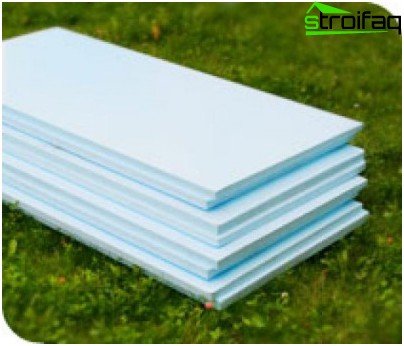
Extruded polystyrene is a lightweight, relatively inexpensive material, a performer without experience can warm the roof with it
Extruded polystyrene foam is the most proven polymer based material. Today it is a significant competitor to the long-familiar materials based on glass and mineral fibers. Expanded polystyrene (polystyrene) does not transfer heat well, and, therefore, contributes to the thermal insulation of the room. It does not create pressure on the supporting structures, as it has a low weight. It is inexpensive, easy to cut and assemble, resistant to mechanical stress.
Fire safety and the possibility of releasing toxic substances during combustion remain open to question. Now, chemicals that prevent fire are added to the polystyrene foam composition. When using polystyrene foam, it is important to organize the proper ventilation of the room, since this type of material is airtight. For roof insulation – this is not the best option.
Polyurethane foam – progressive thermal insulation
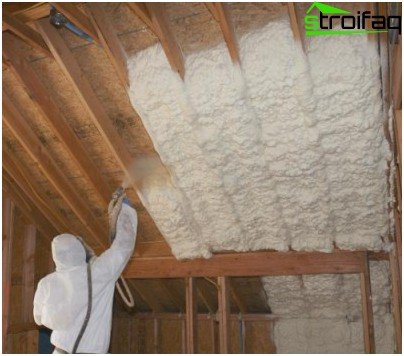
Polyurethane foam insulate the inside of the roof and attics
In this material, solid materials occupy a small volume, and the main space is gas microchambers filled with air or carbon dioxide. Polyurethane foam is resistant to microorganisms and mold, moisture. It has very good thermal insulation properties. Polyurethane service life reaches up to 30 years.
They are insulated with attics and the inside of the roofs. Polyurethane foam is used both in the form of plates (they need to be additionally fixed) and applied directly when performing roofing works. It is economical, with virtually no waste during installation. And sprayed with polyurethane on any surface, providing a seamless waterproof layer.
Other foamed polymeric materials exist. These are foam propylene, foamed rubbers, penoizol, polyolefin foams and others. Choosing this or that material for roof insulation, consider its advantages and disadvantages, type of roof, room ventilation system. Correctly selected material will last a long time and effectively, creating a good microclimate in your home, keeping warm or cool depending on the time of year.


